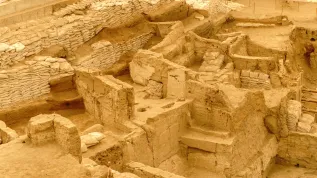
Over nearly 60 years of presence in Palmyra, Polish archaeologists discovered a Roman military camp, temple of Arab goddess Al-lāt, four churches and ancient residential buildings. After the seizure of land by Islamic fanatics, was the work of scientists in vain?
Polish archaeological mission worked in the Syrian Palmyra since 1959 until the beginning of the civil war in 2011. The project was started by the precursor of Polish Mediterranean archaeology, Prof. Kazimierz Michałowski. Since 1973, for almost 40 years the research leader was Prof. Michał Gawlikowski of the Centre of Mediterranean Archaeology of the University of Warsaw.
"Undoubtedly our presence on site was the longest, except the Syrian archaeologists of course. In addition to our work, a number of international missions conducted research in Palmyra during the same period - the French, Swiss, Italian and German missions" - said Prof. Gawlikowski.
A few days ago, the world heard about the murder by Islamic fanatics of 81-year-old Khaled al-Asaad, retired principal custodian of the Palmyra site. The Syrian refused to evacuate and remained in his home in Palmyra. The scholar was accused of being a "guardian of idols" and participating in the archaeological conferences with "infidels". Prof. Gawlikowski told PAP that he had met al-Asaad during his first trip to Palmyra in 1965, when al-Asaad was still a new custodian. He remained at this post until 2003.
"He was always our partner and friend, open to the work of foreign excavation missions. He wanted it to spread the name of Palmyra around the world" - said Prof. Gawlikowski. The scientist emphasised that the custodian of the sights of Palmyra had an extraordinary gift of befriending people - he could talk with passion about the ancient city to both local Bedouins, as well as crowned heads and presidents. Al-Asaad was the most famous Syrian archaeologist, often called "Mister Palmyra".
"Now, Middle East archaeology has through its first martyr" - concluded Prof. Gawlikowski. At the same time, the so-called Islamic State fanatics destroy monuments reconstructed by international teams of conservators, including Poles.
"We know that more than three-meter statue of a lion from the Al-lāt temple, whose fragments we had found and restored in 1977, and then placed in front of the entrance to the museum, has been smashed to pieces by vandals. It is unclear what has been saved from the collections of the museum, reportedly turned into a prison "- explained Prof. Gawlikowski. We know, however, that the current custodian of the ancient Palmyra, al-Asaad’s son, organized the evacuation of several hundred precious statues and monuments that were transported to Damascus.
"We should remember, however, that the greater part of ancient Palmyra still rests safely under the sands of the desert. We estimate that we only unveiled 10-20 percent area of the city. Perhaps, beneath the surface, finds even more interesting than those discovered so far are waiting for future generations of researchers" - wondered the archaeologist.
Prof. Gawlikowski argues that the work of scientists was not in vain. The outcome of Polish research are dozens of scientific articles, which significantly expanded the knowledge about the 2000 years old city. The scale of research and the contribution of researchers from Poland is evidenced by numerous footnotes in foreign literature, referring to the Polish research. In addition, for nearly 50 years the Centre of Mediterranean Archaeology of the University of Warsaw has been publishing "Studia Palmyreńskie", the journal presenting the archaeology of Palmyra, both the ancient city and the surrounding region. The scope of topics presented in the journal includes not only archaeological discoveries, but also the city’s history, its religion, art and epigraphy. Articles are also published in English and French, making it an international journal.
Palmyra was a city that mediated in the trade between the Roman Empire and the Far East - Persia, China and India. Initially, it was a modest caravan town, to finally become one of the largest metropolises in the Mediterranean in the I-II century. It was famous mainly for scenic, monumental stone architecture - the long colonnades and numerous temples dedicated to various gods. Palmyra was added to the World Heritage List of UNESCO in 1980. It was an important tourist attraction in Syria until the beginning of the civil war in 2011. In May this year, the site was captured by Islamic fanatics.
PAP - Science and Scholarship in Poland
szz/ mki/ mrt/
tr. RL













